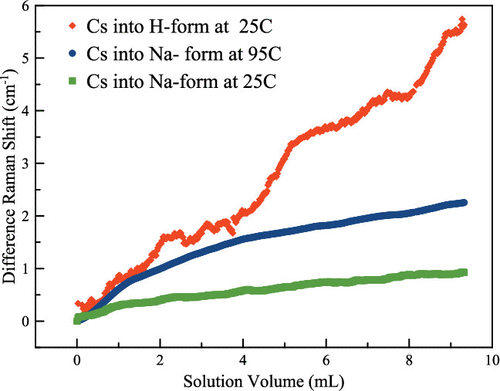当前位置:
X-MOL 学术
›
Inorg. Chem.
›
论文详情
Our official English website, www.x-mol.net, welcomes your feedback! (Note: you will need to create a separate account there.)
In Situ Cs and H Exchange into Gaidonnayite and Proposed Mechanisms of Ion Diffusion
Inorganic Chemistry ( IF 4.6 ) Pub Date : 2019-01-17 00:00:00 , DOI: 10.1021/acs.inorgchem.8b02834 Aaron J. Celestian 1 , Jason Lively 2 , Wenqian Xu 3
Inorganic Chemistry ( IF 4.6 ) Pub Date : 2019-01-17 00:00:00 , DOI: 10.1021/acs.inorgchem.8b02834 Aaron J. Celestian 1 , Jason Lively 2 , Wenqian Xu 3
Affiliation

|
The microporous mineral gaidonnayite Na2ZrSi3O9·2H2O was studied to better understand its ion-exchange mechanisms, specifically for Cs+ and H+ ions. In situ Raman spectroscopy, in situ X-ray diffraction (XRD), simultaneous thermogravimetric analysis and differential scanning calorimetry (TGA/DSC), and in situ X-ray fluorescence were used to determine the exchange processes involved. The Raman spectra contain strong peaks that can be attributed to the vibrational modes for the 3MR symmetric stretch at 500 cm–1, Si–O–Zr–O chain stretches at 938 cm–1, and Si–O stretching in the 1000–1100 cm–1 range. The most prominent Raman shift during ion exchange is found near the 520 cm–1 peak, which corresponds to distortions of the 3MR substructure of gaidonnayite. In all instances of this study, the 3MR exhibited the highest amount of distortion during ion exchange, and the evolution of this distortion is compared to unit-cell changes as measured from XRD data and elemental changes via XRF. The correlations between the Raman, XRD, and XRF data show rapid deformation of the 3MR during the onset of H+ ion exchange in the Na form of gaidonnayite. Even when unit-cell volume changes were small (<3 Å3) as in the cases for Cs+ into Na-gaidonnayite and Cs+ into H-gaidonnayite, significant changes in the ≈520 cm–1 peak were measured. By comparing XRD data and Raman data, and verifying the cation uptake by XRF, we were able to identify and confirm conformational changes and distortions in the crystal structure before, during, and after Cs+ and H+ exchange. Cs exchange occurred the fastest and with the greatest capacity when starting in the H-form at room temperature, and at elevated temperatures when starting in the Na-form.
中文翻译:

原位Cs和H交换成Gaidonnayite及其拟议的离子扩散机理
研究了微孔矿物Gaidonnayite Na 2 ZrSi 3 O 9 ·2H 2 O,以更好地了解其离子交换机理,特别是对于Cs +和H +离子。原位拉曼光谱,原位X射线衍射(XRD),同时热重分析和差示扫描量热法(TGA / DSC)以及原位X射线荧光用于确定涉及的交换过程。拉曼光谱包含很强的峰,这可以归因于3MR对称拉伸在500 cm –1处的振动模式,Si–O–Zr–O链在938 cm –1处的振动模式。,而Si–O的拉伸范围为1000–1100 cm –1。离子交换过程中最显着的拉曼位移在520 cm –1峰附近发现,这对应于Gaidonnayite 3MR子结构的畸变。在本研究的所有实例中,3MR在离子交换过程中表现出最大的畸变量,并且将这种畸变的演变与从XRD数据测得的晶胞变化以及通过XRF进行的元素变化进行了比较。拉曼光谱,XRD和XRF数据之间的相关性表明,在以Na形式的Gaidonnayite进行H +离子交换期间,3MR迅速变形。即使当单元电池体积变化很小(<3埃3),如例针对CS +成Na-gaidonnayite和Cs +进入H-gaidonnayite,测得≈520cm –1峰发生了显着变化。通过比较XRD数据和拉曼数据,并验证XRF对阳离子的吸收,我们能够鉴定和确认Cs +和H +交换之前,之中和之后的晶体结构构象变化和畸变。在室温下以H形开始时,Cs交换发生最快,容量最大,而以Na形开始时,Cs交换在高温下发生。
更新日期:2019-01-17
中文翻译:

原位Cs和H交换成Gaidonnayite及其拟议的离子扩散机理
研究了微孔矿物Gaidonnayite Na 2 ZrSi 3 O 9 ·2H 2 O,以更好地了解其离子交换机理,特别是对于Cs +和H +离子。原位拉曼光谱,原位X射线衍射(XRD),同时热重分析和差示扫描量热法(TGA / DSC)以及原位X射线荧光用于确定涉及的交换过程。拉曼光谱包含很强的峰,这可以归因于3MR对称拉伸在500 cm –1处的振动模式,Si–O–Zr–O链在938 cm –1处的振动模式。,而Si–O的拉伸范围为1000–1100 cm –1。离子交换过程中最显着的拉曼位移在520 cm –1峰附近发现,这对应于Gaidonnayite 3MR子结构的畸变。在本研究的所有实例中,3MR在离子交换过程中表现出最大的畸变量,并且将这种畸变的演变与从XRD数据测得的晶胞变化以及通过XRF进行的元素变化进行了比较。拉曼光谱,XRD和XRF数据之间的相关性表明,在以Na形式的Gaidonnayite进行H +离子交换期间,3MR迅速变形。即使当单元电池体积变化很小(<3埃3),如例针对CS +成Na-gaidonnayite和Cs +进入H-gaidonnayite,测得≈520cm –1峰发生了显着变化。通过比较XRD数据和拉曼数据,并验证XRF对阳离子的吸收,我们能够鉴定和确认Cs +和H +交换之前,之中和之后的晶体结构构象变化和畸变。在室温下以H形开始时,Cs交换发生最快,容量最大,而以Na形开始时,Cs交换在高温下发生。

































 京公网安备 11010802027423号
京公网安备 11010802027423号